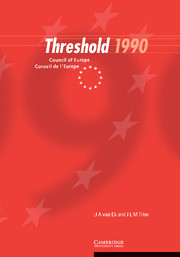Book contents
- Frontmatter
- Contents
- Preface
- Introduction
- 1 The objective: levels of specificity
- 2 The objective: general characterisation
- 3 The objective: extended characterisation
- 4 The objective: components of the specification
- 5 Language functions
- 6 General notions
- 7 Specific notions
- 8 Verbal exchange patterns
- 9 Dealing with texts: reading and listening
- 10 Writing
- 11 Sociocultural competence
- 12 Compensation strategies
- 13 Learning to learn
- 14 Degree of skill
- APPENDICES
6 - General notions
Published online by Cambridge University Press: 26 February 2010
- Frontmatter
- Contents
- Preface
- Introduction
- 1 The objective: levels of specificity
- 2 The objective: general characterisation
- 3 The objective: extended characterisation
- 4 The objective: components of the specification
- 5 Language functions
- 6 General notions
- 7 Specific notions
- 8 Verbal exchange patterns
- 9 Dealing with texts: reading and listening
- 10 Writing
- 11 Sociocultural competence
- 12 Compensation strategies
- 13 Learning to learn
- 14 Degree of skill
- APPENDICES
Summary
Introduction
The list of general notions is derived from a consideration of what, in general, people deal with by means of language, of what concepts they may be likely to refer to whatever the specific features of a particular communication situation may be.
We present the general notions under eight headings:
existential
spatial
temporal
quantitative
qualitative
mental
relational
deixis
The following list indicates the sub-classes of the notions selected and presents the various notions in the form of their exponents. Strictly speaking, we should have presented each notion and its exponent(s) separately, but since the large majority of the notions would then have to be referred to by means of the corresponding exponent – the lexical item among is the exponent of the notion among – this would have led to almost constant duplication without any practical gain.
General notions for Threshold Level including recommended exponents
1 Existential
1.1 existence, non-existence
There is + NP
There's no + NP
There isn't any + NP
the verbs to exist, to become, to make (as in: She ˈmade a ·new ‚dress.)
1.2 presence, absence
here, not here, there, not there, away
1.3 availability, non availability
to have (got)
There is + NP
There's no + NP
There isn't any + NP
ready (as in ˈWhen will it be ‚ready?)
1.4 occurrence, non-occurrenceto happen
2 Spatial
2.1 location
the following adverbs: here, there, everywhere, somewhere, nowhere, (not) anywhere, where?; inside, outside (in) the east/north/south/west to have been to (as in: She has ·been to „Paris.)
this, that, these those
2.2 relative position
the following prepositions of position:
[…]
- Type
- Chapter
- Information
- Threshold 1990 , pp. 48 - 58Publisher: Cambridge University PressPrint publication year: 1998

